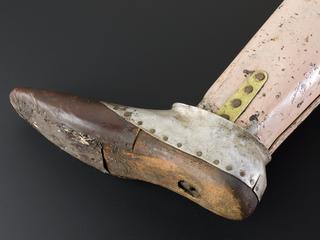
Prosthetic arm, London, 1903-1913
- Made:
- circa 1908 in London






Arm made for a 16 year old girl with a congenital right below elbow amputation, (transverse terminal hemimelia). Because of limited elbow flexion a free-swinging leather cup socket was fitted. The forearm is connected to a lace-up arm corset by side steels thus providing the wearer with full flexion. There is an oval wrist and the rotary face has a 'key-fitting' for a wooden hand with articulated fingers and tenon thumb. In the palm there is a box-fitting to hold eating utensils and other devices. A small plain carrying-hook is in situ. Suspension is by means of a leather shoulder saddle and single strap designed to pass under the opposite axilla. Made by C.A. Hoefftoke, London c.1908.
A 16 year-old girl with a below-the-elbow amputation used this prosthetic arm. It is made of wood, leather and textile. The arm suspends from the body by a leather shoulder saddle and single strap that passes under the opposite underarm. The forearm connects to a lace-up arm corset by steel struts. It provided the wearer with a range of movements. The small wooden hand has fully articulating fingers and a rotating wrist. There is also a small hook fitted in the palm with three locking positions. This is for carrying items such as bags, or grasping utensils such as cutlery. The arm was made by London-based manufacturer C. A. Hoefftoke in the early 1900s.
Details
- Category:
- Orthopaedics
- Object Number:
- 1999-556
- Measurements:
-
overall: 115 mm x 590 mm x 160 mm,
- type:
- artificial arm
- credit:
- Richmond Twickenham and Roehampton Healthcare NHS Trust




